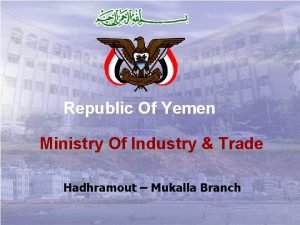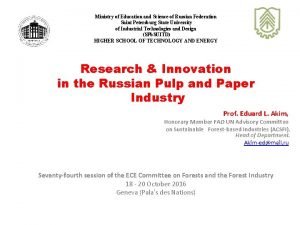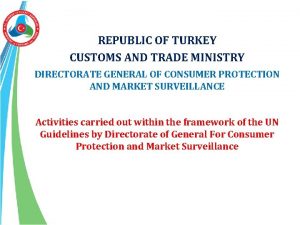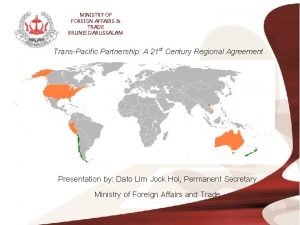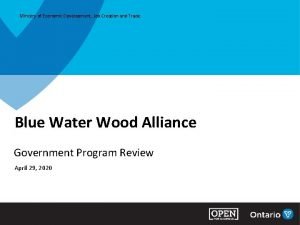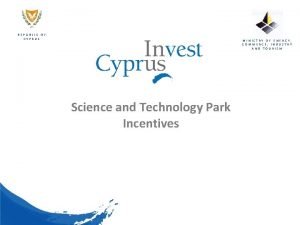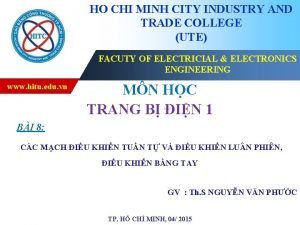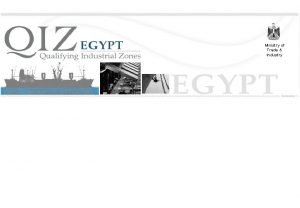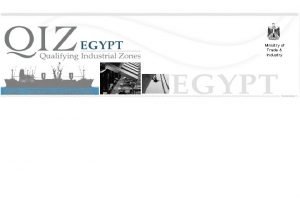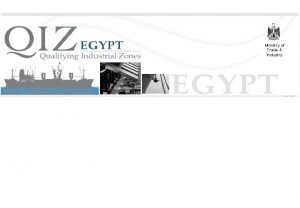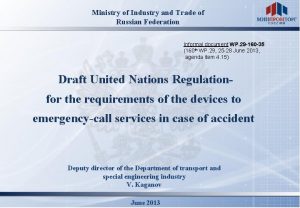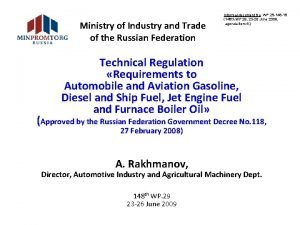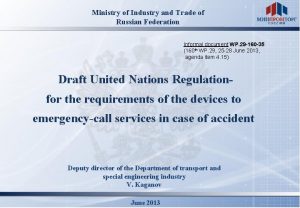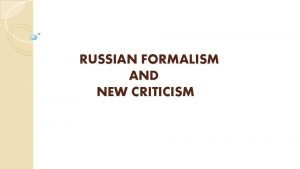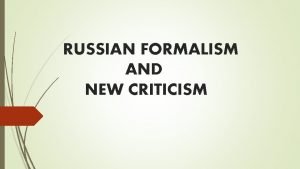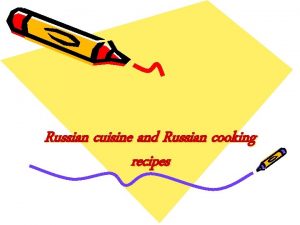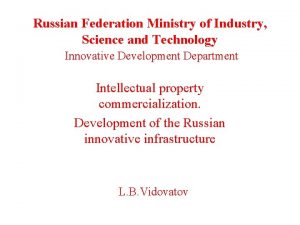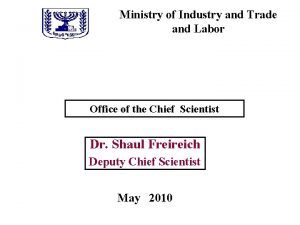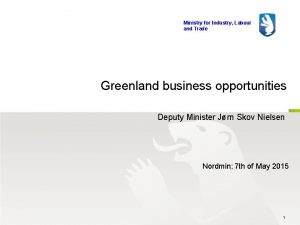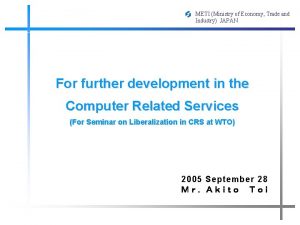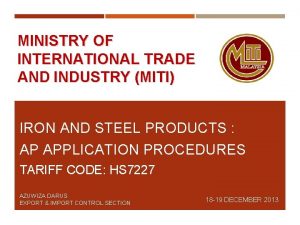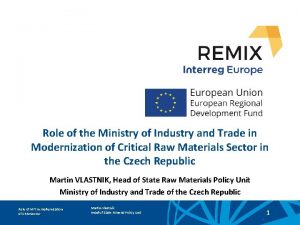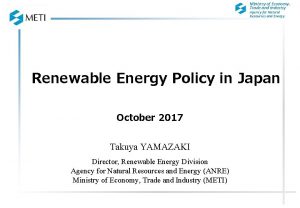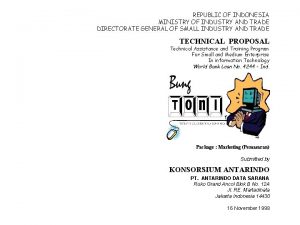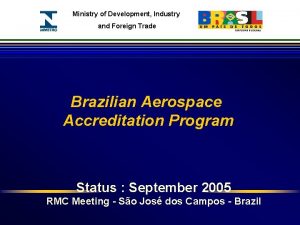Ministry of Industry and Trade of the Russian





















- Slides: 21

Ministry of Industry and Trade of the Russian Federation Informal document WP. 29 -155 -39 (155 th WP. 29, 15 -18 November 2011, agenda item 6) Russian Automotive Industry: Governmental Policies and Priorities Alexey Rakhmanov Director of the Department for Automotive and Agricultural Machinery Industries November 2011

The Principles of Technical Regulation n Assurance of vehicle safety at all stages of the life cycle: from design and production to recycling n Equal requirements to domestic and imported vehicles n Direct application of the international regulations (UNECE Regulations, GTRs) n Establishment of the limited number of the national requirements considering specifics of vehicle operation in Russia n Consideration of the national economy priorities and development 1

The Hierarchy of Technical Regulation UN 2

Introduction of the International Requirements into the National Legislation WP. 29 1958 Geneva Agreement 1998 Global Agreement Before adoption of the UNECE Regulations The Russian National Technical Regulations 3

The Application of the Vehicle Safety Requirements 130 The number of the requirements 116 118 114 110 112 120 110 100 90 80 79 83 87 88 90 92 93 96 101 103 91 114 111 112 109 108 107 123 127 127 122 119 123 123 112 81 93 71 70 63 63 63 57 57 57 73 60 50 40 50 50 51 43 30 42 51 40 40 47 47 47 44 44 51 44 20 10 0 1986 1988 1990 1992 1994 1996 1998 2000 2002 2004 2006 2008 2010 Adoption of the original UNECE Regulations from 1987 The number of the UNECE Regulations applied by the Russian Federation The number of the UNECE Regulations used in the Russian Vehicle Compliance Assessment System The total number of the requirements used in the Russian Vehicle Compliance Assessment System 4

Continuity of a Technical Regulation Policy in Russia Motor Vehicle and Trailer Certification System RF TR 199 3 Customs Union TR 201 0 2013 -2015 Belarus Russia Kazakhstan The development of the technical regulations of the Customs Union started in 2009: Concerning Safety of Motor Vehicle (including vehicle emissions requirements) (TR) Concerning Requirements to the Automobile and Aviation Gasoline, Diesel and Ship Fuel … Concerning Requirements to Safe Recycling of Motor Vehicles 5

The Organizational Structure of the Vehicle Compliance Assessment System in Russia Ministry of Industry and Trade Federal Agency on Technical Regulation and Metrology Technical Secretariat State Research Center NAMI The State Authority on technical regulating The Administrative Department in accordance with the 1958 Geneva Agreement The State Inspection Authority Certification Bodies Test Laboratories 6

The Technical Regulation Concerning Safety of Motor Vehicles The Principle of Safety Verification at the Different Stages of the Life Cycle Vehicle Safety Design Safety Operational Safety Technical policy by the Ministry of Industry and Trade Design n Production Most of vehicle safety parameters are set at the design stage and… …Implemented during manufacturing process Such safety parameters are verified at the moment of release for free circulation n n Technical Policy by the Ministry of Transport and the Ministry of the Internal Affairs Operation Safety parameters of vehicles in operation are also laid down at the design stage and maintained through regular servicing and monitoring of operational conditions Safety parameters are verified regularly through periodic vehicle technical inspections 7

The Objects of Regulating and Compliance Assessment Forms Single vehicles (individually applied for compliance assessment) Vehicle Types Release for circulation Vehicle components Release for circulation – In operation In case of design modification Technical inspection Technical expertise of the design modifications and technical inspection New and used Vehicle Type Approval Technical expertise of the design and technical inspection Release for circulation Declaration of conformity or mandatory certification 8

Compliance Assessment for Vehicle Types New vehicle type Conducting certification tests of the representative samples Analysis of production conditions of the manufacturer • • The type approval number is included into the vehicle passport document The Road Police and Customs Service are informed about the type approval issuance Issuance of the certificates of compliance for separate provisions Issuance of the Vehicle Type Approval Inspection checks of the manufacturer (every two years) 9

Introduction of the Perspective Requirements in the Russian Federation and the Customs Union Automatic Electronic Braking Systems. Lane Departure Warning Systems. Hydrogen and Fuel Cell Vehicles. Pole Side Impact. Vehicle Crash Compatibility. Additional requirements for the Cold Climate Conditions. Infrasound. Requirements to Air Quality Assurance in a Dense Traffic. Tyre rolling resistance (UNECE Regulations № 117 -02) Electronic stability control for vehicle categories М 2, М 3, N 2, N 3 (UNECE Regulations № 13 -11) Tyre pressure monitoring systems(UNECE Regulations № 64 -02) Pedestrian protection (GTR № 9) Tyre wet grip performance (UNECE Regulations 117 -01) Electronic stability control and brake assist systems for vehicle categories М 1, N 1 (UNECE Regulations № 13 -H) Uniform measurement technique of the fuel economy and СО 2 emissions (UNECE Regulations № 101)) Daytime running lamps (UNECE Regulations № 48 -04, 87) properties of an№interior Vehicle heating. Fire-prevention systems UNECE Regulations 122) of buses (UNECE Regulations № 118) splash protection (TR, annex Front underrun. Water protection (UNECE Regulations № 3, 93)chapters 9 -10) Windshield defrosting and demisting systems (TR, annex 3, chapters 7 -8) Tyre noise (UNECE Regulations № 117) 201 0 201 1 201 2 201 3 201 4 201 5 201 6 201 7 201 8 201 9 202 0 10

Industrial Assembly Regime • Initial Industrial Assembly (IA 1) regime was introduced in 2004 and changed the landscape of the Russian Automotive Industry: • new factories were built, new cars introduced to the market • new manufacturing process and approaches were widely spread even at the domestic plants • new component manufacturers were investing in Russia • However, IA 1 regime with the required 25 000 capacity although universal for various brands and price categories was not serving the strategic goal • Strategy of the Russian Automotive Industry development was prepared in 2009 -2010 and was approved by the Government in April 2010 • Main purpose of the Industrial Assembly Regime modification (IA 2) was to ensure the key strategy tasks achievement through deeper foreign car components localization and development of the component industry in Russia • Key OEMs with diversified product portfolios who intends to view Russian plant as part of the global manufacturing footprint can be key beneficiaries of the new regime 11

Key Principles of the Modified Industrial Assembly Regime • Legal Basis – signature of the amendments to the existing “industrial assembly” agreements for the term of 8 years (but not later than until 31 December 2020) for the companies that are in full compliance with the terms and conditions of the current agreements • Volume Requirements – new or modernized capacity of 300/350 thousand units (including available full scale production capacity) shall be built within 36 – 48 months after the entry into force of the amendment • Engines and Transmissions - production in Russia (no volume threshold) provided that 30% of the vehicles produced in Russia are equipped with engines manufactured locally in 36 -48 months after the date of amendment • • Local Content Formula - L=(1 -V/P)*100%, where • L – average value added for the model range • V - total customs value of all imported parts • P – total value of cars sold (net of VAT, excise tax, dealer bonuses/rebates and internal revenues) Y 1 Y 2 Y 3 Y 4 Y 5 Y 6 • Localization schedule for new capacity builders 0% 0% 0% 30% 40% 60% • 35% Localization schedule for companies modernizing capacity 40% 45% 50% 55% 60% • Limitation of SKD – Duty free importation of SKD kit is allowed for first 36 months in amount not exceeding 5% of available full production cycle capacity in any given year. The quota is defined and confirmed annually. • Alliances establishment - new obligations can be implemented by a group of cross-owned affiliated entities producing vehicles on common platforms with clear joint responsibility of all entities. One reporting entity can be appointed for this purpose • R&D center with certain capabilities shall be established in Russia 12

New Industrial Assembly Features 1. Average value added calculation example for the model lineup manufactured by a candidate: Total: Production volume, K units 10 45 150 95 Vehicle price level Model value added, % 300 Average Value Added 10% 40% 80% 45% 60% 2. The target is to reach an average value added of 60% within 6 years after the date of the amended agreement. 3. OEMs will be held accountable for localization of powertrain, axles and stampings 4. Component localization requirements and schedules are set in a separate annex to the Decree covering all major groups of parts: in general OESs will have a target localization rate of 45% within 6 years calculated the same way as for OEMs Local content requirement for components suppliers is split into three phases: First stage: 2011 -2014 Second stage: Third stage: 2015 -2017 2018 -2020 the level of production localization is not less than 15% localization is not less than 30% localization is not less than 45% 13

Three Tiers of OEMs in Russia Strategic Alliances and Partnerships Renault-Nissan-Аvто. VAZ (2) JV КАМАZ-Mercedes-Fuso (2) JV Sollers-Ford (2) OEM Projects General Motors Group (2) Volkswagen Group (2) License Production and Contract Assembly Free Economic Zone Regime Duty Paid Production To be reconsidered as OEM Project 14

Automatic Traffic Accidents Information System ERA-GLONASS What is it? n On-board communication terminal for automatic emergency calls/messages, deceleration transducer unit, data recording, communication through networks GSM 900/1800 and UMTS; automatic data transmission and ability of voice communication Open Issues n Necessity of adaptation to a vehicle design and compatibility with the original on-board electronic control units and signaling systems n Infrastructure for responding to emergency calls shall be established and verified n Alignment and harmonization with the EU system ‘e -Call’ n Timing of enforcement of the requirements should be agreed by the stakeholders 15

The Means of Detection of Ethanol in the Exhaled Air (Alcolocks) Thousa nd 250 acciden ts 200 150 100 50 0 2007 2008 2009 2010 Number of accidents caused by drunk drivers n The Legislator’s decision is pending n Potential installation of “alcolocks” initially in the commercial passenger and dangerous goods transportation vehicles n Installation of alcolocks in the vehicles of the persons, who incurred liability for drunk driving n Alignment and harmonization with the EU requirements n Enforcement of the requirements should be agreed by the stakeholders 16

Customs Union Technical Regulation on Vehicle Emissions The Technical Regulation Concerning Requirements to Emissions of Harmful (Polluting) Substances of Automotive Vehicles, Released for Circulation on the Territory of the Russian Federation → Technical Regulation of the Customs Union Concerning Safety of Motor Vehicles New vehicles built on chassis of other vehicles New vehicles Customs Union New vehicle types ‘ 1 3 ‘ 1 4 ‘ 1 5 ‘ 1 6 ‘ 1 7 ‘ 1 8 ‘ 1 9 ‘ 2 0 New vehicles built on chassis of other vehicles Russia New vehicles New vehicle types EU Euro-0 ’ 9 8 ‘ 9 9 ‘ 0 0 Euro-1 ‘ 0 1 Euro-2 ‘ 9 8 ‘ 9 9 ‘ 0 2 ‘ 0 3 ‘ 0 4 ‘ 0 5 Euro-3 ‘ 0 0 ‘ 0 1 ‘ 0 2 ‘ 0 3 Euro-2 Euro-3 ‘ 0 6 ‘ 0 8 ‘ 0 7 ‘ 0 9 Euro-4 ‘ 0 5 ‘ 0 6 Euro-4 ‘ 1 0 ‘ 1 1 ‘ 1 2 Euro-5 ‘ 1 3 ‘ 1 4 ‘ 1 5 ‘ 1 6 Euro-5 ‘ 0 7 ‘ 0 8 ‘ 0 9 ‘ 1 0 ‘ 1 1 ‘ 1 7 Euro-6 ‘ 1 2 ‘ 1 3 ‘ 1 4 ‘ 1 5 ‘ 1 6 ‘ 1 7 17

ELV Policy and Recycling (1) Draft Technical Regulation of the Customs Union concerning the requirements to motor vehicles in regards to the provision for their safe recycling is now being discussed by three parties: Russia, Belarus and Kazakstan Vehicle Types Components Recycling Processes • Category M • Category N • Category O • New types delivered as replacement (spare) parts • Re-used vehicle components • Collecting, storage • Disassembling and recycling • Restoration of components 18

ELV Policy and Recycling (2) n The provisions of the Draft Technical Regulation have been harmonized with the legislation of the EU and the ISO International Standards n The Vehicle of categories M 1 and N 1 shall have the recyclability rate of at least 80% and the disposal rate of at least 85%; for the other vehicle categories the recyclability rate shall be at least 85% and the disposal rate of at least 90% n The requirements to the marking of the parts and providing information concerning the vehicle disassembling order for the disposal enterprises n The expected enforcement of the Technical Regulation for vehicles of categories М 1 and N 1 in 2014; for the rest vehicle categories in 2020 n Arrangement for financing and administrational matters to be agreed between different models: fund (Netherlands), individual schemes, collective schemes 19

Thank you for your attention! Ministry of Industry and Trade Website: http: //minpromtorg. gov. ru 20
 Ministry of industry and trade yemen
Ministry of industry and trade yemen Ministry of education and science of the russian federation
Ministry of education and science of the russian federation Ministry of customs and trade turkey
Ministry of customs and trade turkey Ministry of foreign affairs and trade brunei
Ministry of foreign affairs and trade brunei Ministry of economic development job creation and trade
Ministry of economic development job creation and trade Ministry of energy commerce and industry cyprus
Ministry of energy commerce and industry cyprus Trade diversion and trade creation
Trade diversion and trade creation Umich
Umich Which is the most enduring free trade area in the world?
Which is the most enduring free trade area in the world? Trade diversion and trade creation
Trade diversion and trade creation Tramp liner
Tramp liner Ho chi minh industry and trade college
Ho chi minh industry and trade college The trade in the trade-to-gdp ratio
The trade in the trade-to-gdp ratio Fair trade not free trade
Fair trade not free trade Ted talk atlantic slave trade
Ted talk atlantic slave trade Hình ảnh bộ gõ cơ thể búng tay
Hình ảnh bộ gõ cơ thể búng tay Bổ thể
Bổ thể Tỉ lệ cơ thể trẻ em
Tỉ lệ cơ thể trẻ em Chó sói
Chó sói Tư thế worms-breton
Tư thế worms-breton Chúa yêu trần thế alleluia
Chúa yêu trần thế alleluia
